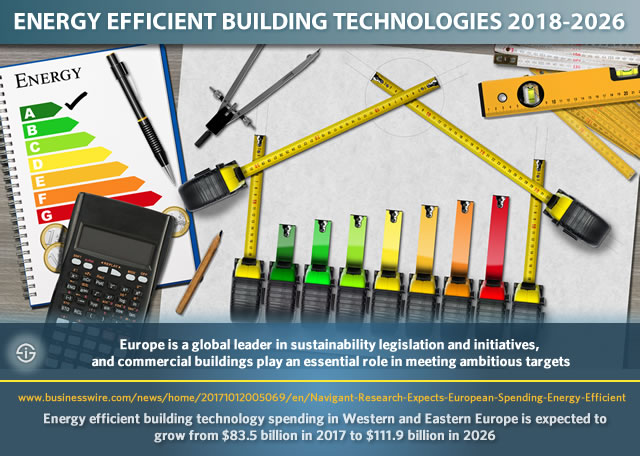Saying that the evolutions with regards to smart building technologies are highly influenced by regulatory challenges (sustainability) and building owner and tenant expectations with regards to green buildings, energy efficiency and ecology is probably an understatement.
The building management systems market is driven by it as BMS expert Martin Feder who is responsible for the BMS certification of the EcoXpert partner program reminded in our interview on building management evolutions and drivers in the connected age. And it sure drives demand for energy efficient building technologies, leading to higher energy efficient building technology spending, the topic of this article. It won’t come as a surprise that the IoT and big data analytics are among the key enabling technologies.
The mentioned evolutions are a universal given. However, across Europe regulations in several countries outside of the EU, the EU’s ‘Clean Energy for All Europeans’ package and the recent approval of amendments to the Energy Performance of Buildings Directive (EPBD) have a major impact on the evolutions in the smart building and energy efficient building technologies space.
This is also the case in other countries with the increasing importance of green building certifications such as US initiative LEED (Leadership in Energy and Environmental Design) that is expanding across the globe.

Energy efficient building technology spending: data, drivers and differences
Yet, certainly in the current geo-political climate, on the level of awareness and perception with regards to climate change and ecology, of which energy efficiency and green buildings are also part (on top of cost reduction and so much more) Europe seems to be the place for intelligent building technologies vendors, system integrators and ecosystems. This is further enhanced by measures to boost renovation initiatives, both in commercial and residential buildings.
Energy efficient building technologies across Europe: near $112 Billion in 2026
According to a report from Navigant Research, announced on October 12th 2017, spending on energy efficient building technologies alone is expected to be close to $112 Billion in 2026 in the whole of Europe.
Although not being the only driver, Navigant Research points to the fact that Europe has been a global leader in sustainability legislation and initiatives, with commercial buildings playing an essential role in meeting ambitious targets as principal research analyst Tom Machinchick puts it.
Different energy efficient building technology market drivers in Western and Eastern Europe
The press release about the report points to differences in the drivers in Western and Eastern Europe (although there are of course de facto overlaps).
- In Western Europe the agenda is more driven by the commitment to energy- and emissions-related goals. Legislation such as the soon to be revised Energy Performance of Buildings Directive (EPBD) and the Energy Efficiency Directive (EED) is mentioned as a key driver in Western Europe or at least in the EU where both directives apply. According to Navigant it will help the EU to achieve deeper building efficiency while retaining gains.
- In Eastern Europe energy efficiency priorities are more related with the energy infrastructure reliability and efficiency overall. However, here too building efficiency is getting higher on the agenda.
The Navigant Research report looks at energy efficient building technologies in several areas, including HVAC, lighting, building controls, water efficiency, water heating, building envelope, commissioning and installation. It is segmented by commercial building type and new construction or renovation spending (retrofit). Boosting renovation ranks high on the priorities agenda of the EU’s ‘Clean Energy for All Europeans’ package and revised EPBD.
The role of IoT and advancements in intelligent building systems in energy efficient building technology spending
To put the growth of the energy efficient building technologies in Europe in perspective: while in 2026 the market would near $112 Billion in 2026, it is good for $83.5 billion in 2017.
Do note that mainly commercial buildings will play an essential role and that on top of the mentioned drivers in respectively Western and Eastern Europe the evolutions with regards to the technologies that enable smart buildings and intelligent energy efficient buildings (where the building management system is at the core as the digital hub of connectivity, to quote Martin Feder) are also key.
To quote from the Navigant press release: “Advancements in intelligent building technologies are evolving toward an integrated ecosystem of components and sensors that work together as a platform for optimizing facility operations”.
We would even expand that ecosystem beyond the technologies themselves as ecosystems and partnerships are key in the intelligent building and building technologies space where, among others, the Internet of Things and demand for advanced analytics lead to a de facto integration and connectivity which also affects channel partner ecosystems. The Internet of Things is clearly a key force in it all and is essential in critical power buildings, large, medium and smaller commercial buildings and in the smart home as well.
More information about the Navigant Research report on the dedicated page where you can also ask a summary or buy it: “Market Data: Energy Efficient Buildings – Europe“.
Top image: Shutterstock – Copyright: Alberto Masnovo

